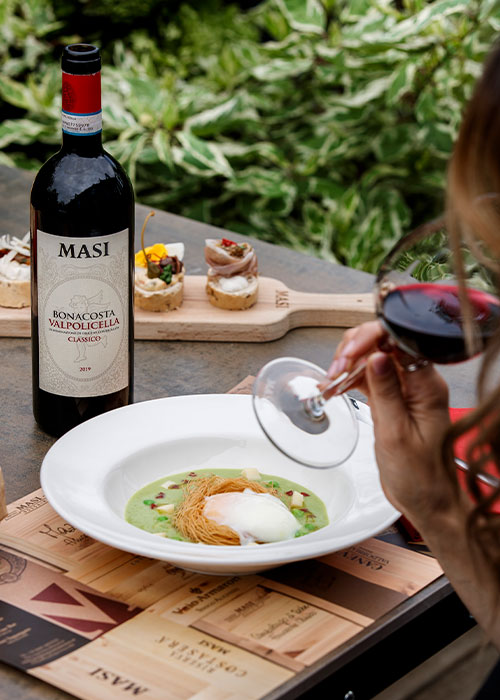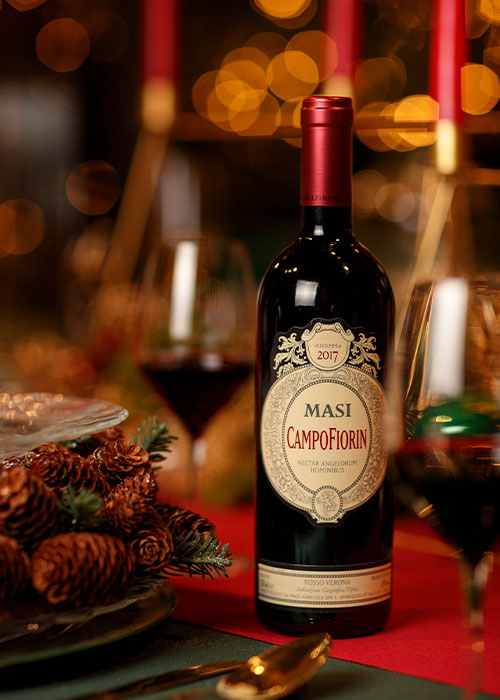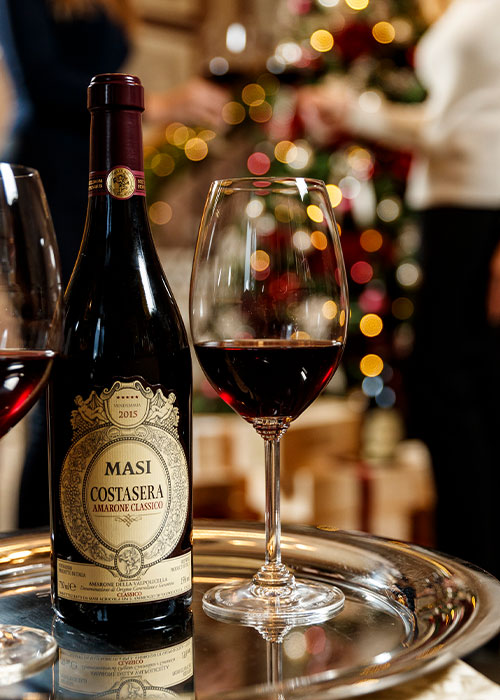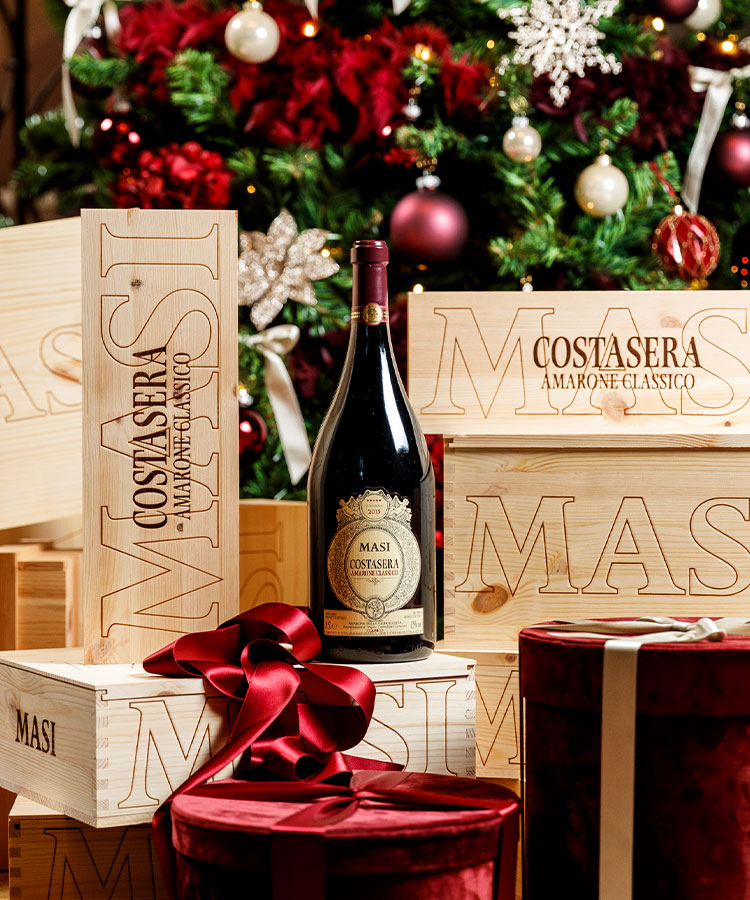
In 1772, the Boscaini family acquired a few choice vineyards in the Vaio dei Masi valley and started making wine. In the nearly 250 years since, the family — now in its sixth and seventh generations of winemaking — has become known across the globe. The transition from famous to forgotten can happen as easily to a wine as it does a Hollywood star. Take, for example, Valpolicella, the red wine from Italy’s Veneto region. The wine once loved by Frank Sinatra, Federico Fellini, and Ernest Hemingway, who called it “a wine as congenial as a brother’s house,” Valpolicella is now a rare presence on restaurant wine lists and retail shelves.
The secret to the Boscaini family’s success? Ultimate respect for this tiny, hilly region between Lake Garda and Verona where the soil is rich and the water supply is ample. Masi’s single vineyard— or cru — wines express the unique characteristics of each site. Though many of these cru wines are made with a similar grape blend, each is distinctive.
Masi works with indigenous Veronese grape varietals, including Corvina and Rondinella, which you may not know by name, but are integral to the production of these world-class wines. Masi champions the elegance and history of this region and has set more stringent production standards for its benchmark wines.

Their time-honored winemaking techniques date back to ancient Rome, especially the famed appassimento method used for making Amarone. Grapes are dried on bamboo mats over the winter to concentrate their flavor before being vinified. They have also pioneered new techniques, such as the double fermentation technique using semi-dried grapes in modern winemaking. The grapes for Masi’s Costasera Amarone are dried in lofts equipped with a NASA “natural appassimento” climate control system, which is used when high humidity threatens mold development on the drying grapes.
Within this lineup are both daily drinking wines, suitable for takeout or picnics, and age-worthy powerhouses that can mark special occasions such as birthdays, holidays, or anniversaries. They also make thoughtful gifts. These versatile wines will take you from simple autumn dinners to grand winter celebrations.
BONACOSTA VALPOLICELLA CLASSICO DOC
Bonacosta, the base of the rolling hills where grapes for Amarone are grown, is marked by rich topsoil and gentle breezes. Its namesake wine is as friendly as Valpolicella itself. Grapes are harvested separately, fermented, then aged in oak barrels. Twenty percent of the Corvina is aged in new Allier and Slavonian small oak casks, while the rest of the blend is aged on Slavonian oak of different usages and passages for four months.
With its crimson hue and rich notes of cherries and herbal edge, Bonacosta pairs beautifully with the bounty of autumn food, from slow-cooked pork, to hearty root vegetable soups and stews, to risotto. The gentle tannins and long, fruit-driven finish make the wine pairable with richer foods. But the smoothness and balanced acidity keep it fresh and suitable for those quick autumn meals like a charcuterie board, a garden salad, or even a BLT. It offers a weeknight-friendly price point, yet is elegant enough to serve at a special dinner or to offer as a host gift.

CAMPOFIORIN ROSSO DEL VERONESE IGT
Hailing from the stream-streaked valleys of Verona’s hills, with alluvial terrain on limestone, Campofiorin is something special. It’s not the fresh and vibrant Bonacosta; neither is it the majestic Costatera Amarone. Instead, it is a marriage of the two techniques. Fresh grapes are fermented, then refermented with a portion of semi-dried grapes. This is called double fermentation, and it boosts the color, aroma, and concentration of the finished wine.
Campofiorin offers the same dark cherry aromas as Bonacosta, plus vibrant notes of ripe raspberry and baking spices. While it can be enjoyed on its own, the smooth tannins and acidity offer plenty of structure to go with hearty braised meats and rich pastas like gnocchi Bolognese or a slow-simmered ragu with spaghetti. Likewise, it pairs as beautifully with a cheeseburger as it does with mushroom risotto or game meats like duck or elk. And for cheese enthusiasts, this wine is a lovely pair with hard cheeses like Gruyere, or Piave Vecchio from the Veneto.

COSTASERA AMARONE DELLA VALPOLICELLA CLASSICO DOCG
There are few wines as unique as Amarone. The grapes for Costatera Amarone are grown on the west- and south-facing hillside vineyards, with friable red limestone and marl.
Grapes are picked in late September and early October depending on the vintage, with the best clusters set aside to be dried for three to four months. After losing about 35 percent of their original weight, they are fermented in a mix of stainless steel tanks and Slavonian oak barrels. This ancient winemaking technique, called apassimento, is now loved for its ability to bring out big, concentrated flavors and colors in wine. It also offers immense aging potential, up to 35 years’ worth.
This midnight-ruby-hued wine offers striking notes of cherry balsamic compote and plum jam, with hints of fennel seeds, cinnamon, and clove. The velvety tannins and smooth acidity help keep a delicate balance.
Amarone is famously a wine to sip and ponder and enjoy. It also complements roasted or charred meats, such as wood-fired steak, rack of lamb, or wild boar. It’s often served after a meal, either solo or with a hunk of aged Parmigiano Reggiano drizzled with honey.
Whether you’re enjoying leftovers on a sunny fall afternoon or feasting on roasted meats on a cold winter’s night, Masi wines offer supreme versatility and pairing options.
This article is sponsored by Masi.
